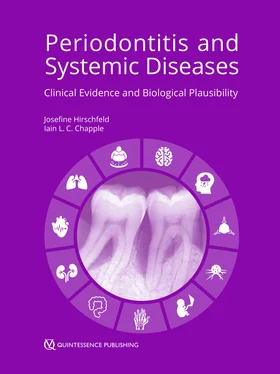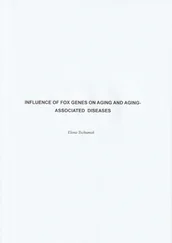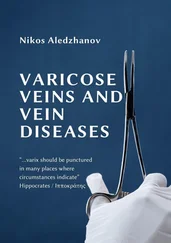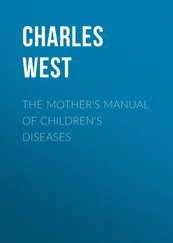Jimenez et al 31examined the association between measures of adiposity and self-reported periodontitis, using data from more than 36,000 healthy male participants of the Health Professionals Follow-Up Study, who were periodontally healthy at baseline and were followed for more than 20 years. They observed that overweight and obesity increase the risks of having periodontitis (hazard ratio [HR] 1.09, 95% CI 1.01 to 1.17, and HR 1.30, 95% CI 1.16 to 1.45, respectively). When the obesity data was broken down among dental and non-dental professionals, they only observed a significant association in the first group (HR 1.52, 95% CI 1.32 to 1.75 vs. HR 1.07, 95% CI 0.90 to 1.27). Regarding the waist ratio, subjects with more than 40.25 inches in waist circumference exhibited a 25% (95% CI 1.09 to 1.44) increased risk of periodontal disease compared with men with less than 40.25 inches. All data were adjusted by age, number of teeth at baseline, physical activity or fruit and vegetable intake. It is important to highlight that periodontitis was self-reported in this study, thus the lack of an expert diagnosis is likely to introduce some errors and biases in the study outcomes.
Gorman et al 32found that a 1% increment in waist-to-height ratio was associated with a 3% increase in the HR of having periodontitis progression over 27 years, and an augmentation of 1 cm in waist circumference was associated with a 1% to 2% increase in the hazard of periodontitis in 1038 white males. Obese subjects had an HR of 1.52 (95% CI 1.05 to 2.21) for having clinical attachment loss greater than 5 mm and an HR of 1.60 (95% CI 1.07 to 2.38) of having alveolar bone loss greater than 40% of more than two teeth when compared to normal weight counterparts. Furthermore, treatment outcomes may be diminished by obesity: Martinez-Herrera et al 33reported, in their systematic review, that obesity had an impact on the outcome of scaling and root planing in patients with periodontitis in three of the 28 studies included. On the other hand, six studies did not show this impact. Conclusions are difficult to draw because of the high methodological heterogeneity in terms of evaluation of the periodontitis outcome measures used, risk factors analysed, and age and gender of the participants in the different studies. In a cross-sectional study published by the same group, the authors observed that periodontitis was more prevalent in obese subjects (80.9% vs. lean 41.2%), with a six-fold increased risk of having periodontitis. In addition, obese subjects displayed higher diastolic blood pressure, increased circulating tumour necrosis factor alpha (TNF-α) and high-sensitivity C-reactive protein (hsCRP), as well as lower high-density lipoprotein (HDL) than lean subjects. Interestingly, obese subjects with insulin resistance had higher systolic blood pressure, higher glucose, insulin, HbA1c and triglyceride levels, more insulin resistance (HOMA-IR [homeostatic model assessment of insulin resistance]), and a higher number of teeth with probing depths greater than 4 mm than those obese subjects without insulin resistance 34.
D’Aiuto et al 35analysed data from almost 14,000 men and women from the third NHANES in the United States and observed that subjects older than 45 years with severe periodontitis were 2.31 times more likely to have metabolic syndrome, defined by concurrence of hypertension, atherogenic lipid profiles, obesity and insulin resistance; compared to unaffected individuals after adjusting for confounders. Furthermore, diagnosis of metabolic syndrome increased by 1.12 times per 10% increase in gingival bleeding and 1.13 times per 10% increase in the proportion of periodontal pockets. Morita et al 36followed up more than 3000 Japanese workers for 5 years and assessed the incidence of periodontitis. They observed a significant association between BMI and the development of periodontal pockets of greater than 4 mm, and the hazard ratios for women were higher than they were for men. However, this study used partial-mouth recording and the Community Periodontal Index to assess periodontal status, which would underestimate the true periodontal status. Merchant et al 37observed in 39,461 males that individuals who maintained a normal weight, pursued regular exercise, and consumed a diet in conformity with the Dietary Guidelines for Americans and the Food Guide Pyramid recommendations, were 40% less likely to have periodontitis.
In addition, periodontal pathogen populations seem to be altered in obese subjects. For example, Haffajee and Socransky 38observed an overgrowth of Tannerella forsythia in the biofilms of periodontally healthy obese individuals that might put them at risk for initiation of periodontitis. They also observed that the ORs of overweight and obese subjects exhibiting periodontitis were 3.1 (95% CI 1.9 to 4.8) and 5.3 (95% CI 2.8 to 9.5), respectively, when compared with subjects with normal BMI. Logistic regression analysis indicated an OR of 2.3 (95% CI 1.2 to 4.5) for an obese subject to exhibit periodontitis after adjusting for age, gender and smoking status. In a recent study, Maciel et al 39observed that obese male subjects with periodontitis harboured higher levels and/or higher proportions of periodontal pathogens, such as Aggregatibacter actinomycetemcomitans, Eubacterium nodatum, Fusobacterium nucleatum subspecies vincentii, Parvimonas micra, Prevotella intermedia, T. forsythia, Prevotella melaninogenica and Treponema socranskii when compared to normal weight subjects with periodontitis. Furthermore, the healthy sites of the obese subjects also exhibited higher proportions of some of the pathogens than the normal weight counterparts 39.
In terms of treatment outcome, Suvan et al 40investigated the predictive role of overweight/obesity on clinical response following non-surgical periodontal therapy in 260 adults. On re-evaluation, i.e., after 8 weeks, they observed that obesity was an independent predictor of poorer periodontal treatment outcomes. These patients had, on average, 3.2% (95% CI 0.7% to 5.6%) more sites with probing depths greater than 4 mm when compared with normal weight subjects after adjustment for the baseline. For every BMI increase of 10 kg/m 2, the mean percentage of sites with probing depths greater than 4 mm increased by 2.5% (95% CI 1.10% to 3.80%). No differences were found in bleeding on probing. It is worth pointing out that the magnitude of this association was similar to that of smoking, which was also linked to a worse clinical periodontal outcome 40. However, Palomo 41stated that this study had limitations inherent in the study design. The confounders for periodontitis, such as smoking and diabetes, were not part of the exclusion criteria. Instead, statistical analysis was undertaken to account for them, increasing the risk for false-positive associations. Thus, a poor outcome after periodontal therapy in the obese patients of this study may in fact not be fully attributed to the BMI alone 41.
It is difficult and complex to unravel the relative contributions of obesity and metabolic status, including hyperglycaemia, to periodontitis. Positive association between obesity and periodontitis has been consistently shown in recent meta-analyses. However, few of them have a prospective or a longitudinal design, and these relationships appear to be modest 26. Taken together, there is significant evidence of an association between overweight/obesity and the prevalence, extent and severity of periodontitis, as well as periodontal treatment outcomes in children, adolescents and adults. However, the magnitude and mechanisms of this association require further clarification. The available evidence comes mainly from cross-sectional, experimental and longitudinal studies, respectively 33 , 42. The difficulty to reach a final conclusion is related to the difficulty to evaluate the mechanisms underlying the association between them, because most of the studies involved a cross-sectional design. In addition, there is heterogeneity in the definition of obesity in most of the studies, which evaluate the degree of obesity by calculating BMI, however some of them also include wait-circumference, waist-hip ratio and, in some cases, percentage body fat. In order to confirm the causal relationship and the pathophysiological mechanism involved in the association between obesity and periodontitis, further prospective studies are needed 33 , 42.
Читать дальше











![John Bruce - The Lettsomian Lectures on Diseases and Disorders of the Heart and Arteries in Middle and Advanced Life [1900-1901]](/books/749387/john-bruce-the-lettsomian-lectures-on-diseases-and-disorders-of-the-heart-and-arteries-in-middle-and-advanced-life-1900-1901-thumb.webp)
